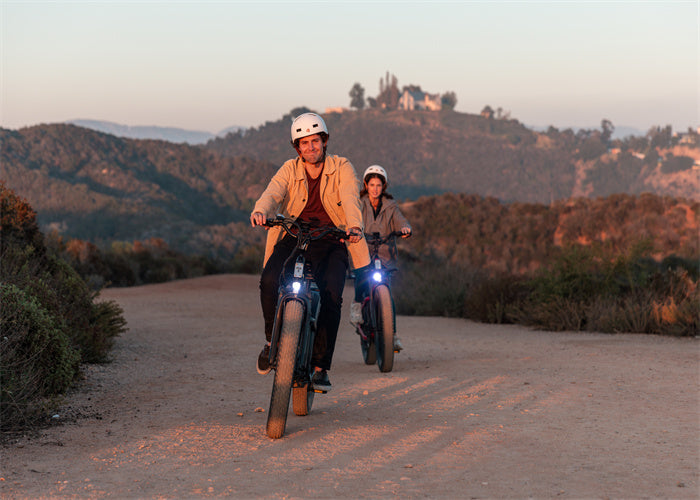What is a Speed Sensor on an Electric Bike
A speed sensor on an ebike measures the rotational speed of the wheel to provide accurate speed readings.
These sensors monitor speed and assist in controlling the motor's assistance level.
The sensor is either integrated into the motor or attached to the wheel's spokes, depending on the ebike model.
Speed sensors detect the rotation of the wheel and send this data to the bike's display unit.
This information allows riders to rely on precise speed readings for various reasons, including adhering to speed limits, optimizing battery usage, and enhancing overall riding safety.
The speed sensor ensures that the ebike operates smoothly and efficiently by gauging the wheel's rotational speed and adjusting the motor's assistance.
How do I Find My Ebike Speed Sensor
Locating the speed sensor on your ebike varies based on the make and model of the bike.
The speed sensor is placed in a position where it can accurately measure the wheel's rotations.
Common locations include the rear wheel hub, the crankset, or the chainstay.
To find your ebike speed sensor, check the rear wheel hub for any small devices or wiring that could indicate the presence of a sensor.
Inspect the crankset for a small magnet and sensor setup, common in mid-drive motor systems.
Examine the chainstay, the horizontal part of the bike frame near the rear wheel, for a sensor attached with a magnet on the wheel spokes passing by it.
Properly locating and maintaining the sensor will help you get accurate speed readings and optimize your riding experience.
How Does a Speed Sensor Work on a Bike
The speed sensor on a bike detects the wheel's rotational speed and converts this data into an electrical signal transmitted to the bike's control system.
This process involves key components working in harmony to ensure accurate speed measurements.
The core components of a speed sensor system include a magnet attached to the wheel spokes and a sensor mounted on the frame or fork.
As the wheel rotates, the magnet passes by the sensor at regular intervals. The sensor detects the magnetic field changes caused by the passing magnet.
Each time the magnet passes the sensor, an electrical signal is generated. These signals are counted and transmitted to the bike's control unit.
The control unit processes the signals to calculate the wheel's rotational speed. It then converts this data into the bike's speed, displayed on the handlebar-mounted screen or dashboard.
The control unit uses the speed data to adjust the motor's power output. If the bike detects that you are going uphill and your speed decreases, the motor will provide more assistance to maintain a consistent riding experience.
How to Fix Ebike Sensor Error
Check for physical damage. Inspect the sensor and magnet for any visible damage or misalignment.
Ensure that the magnet on the wheel spokes is properly aligned with the sensor. Clean the sensor and magnet. Dirt, dust, and debris can interfere with the sensor's operation.
Clean both the sensor and the magnet using a soft cloth and ensure they are free from any obstructions. Inspect the wiring and connections. Loose or damaged wiring can lead to sensor errors.
Check the connections between the sensor and the bike's control unit. Ensure that all wires are securely connected and free from damage.
If the issue persists, reset the system. Turn off your ebike, wait for a few minutes, and then turn it back on.
This can help reset the system and clear any temporary glitches. Some ebikes require sensor calibration to function correctly.
This process usually involves aligning the sensor and magnet properly and performing a series of steps to ensure accurate readings.
Another common fix is updating the firmware.
Check the manufacturer's website for any available updates and follow the instructions to install them.
If you notice persistent errors, it could be due to more complex issues such as sensor misalignment, damaged wiring, or even a faulty sensor.
You can test the sensor using a multimeter to ensure it is producing the correct signal. If the sensor is faulty, replacing it may be necessary.
Maintaining your speed sensor in good working condition is crucial for the optimal performance of your ebike.
Regular checks and maintenance can help prevent sensor errors and ensure that your bike operates smoothly and efficiently.
FAQs
How does sensor calibration help?
Calibration ensures the sensor and magnet are aligned correctly, providing accurate speed readings.
Can environmental factors affect the speed sensor?
Yes, factors like mud, water, or extreme temperatures can affect the sensor's performance.
What are the signs of a failing speed sensor?
Inconsistent speed readings, frequent error codes, and reduced motor assistance are common signs of a failing speed sensor.







Share:
Should you buy an electric bike with UL certification
Solutions for Ebike PAS Always Going Full Speed